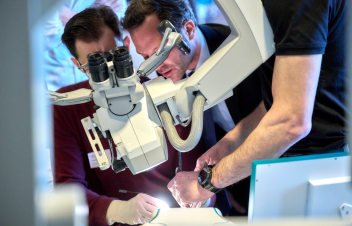Revolutionizing Neurosurgical Training: Explore the Clinical Evidence Behind Simulators
- surgeonslab1
- Jun 7, 2024
- 4 min read
Neurosurgery can be regarded as one of the most demanding fields of medicine, and it requires extensive and rigorous neurosurgeon training to perform very delicate operations. Neurosurgical teaching has been didactic and involved prosecution demonstrations with cadavers and observation of the senior clinicians during operations.

Assistive technology has been the primary concern, more or less detrimental to neurosurgical educational methods, although the recent advent of simulation technology has paved the way for improved techniques for neurosurgical training. In this article, we shall dissect some clinical evidence about the application of simulators in neurosurgical training and how the modality is influencing the way neurosurgeons acquire new skills.
The Emergence of Neurosurgical Simulators
Neurosurgical simulators are available in various levels of complexity from basic to complex immersive virtual reality systems. Realistic models like the synthetic skull models are important because they are used to explain general skills in drilling and dissection. High-fidelity simulators, however, provide more realistic models and enable the reproduction of specific operations.
Virtual reality simulators go a step further by placing the trainees in realistic scenarios whereby they perform arbitrary surgeries in a simulated environment. Such simulators are effective complements to the conventional modes of clinical training, enabling the residents to practice in an efficient manner. Firms such as SurgeonsLab are in the process of creating complex surgical simulators specifically aimed at neurosurgical education.
Clinical Evidence Supporting Simulation in Neurosurgery
Several past researches have provided clinical evidence neurosurgical simulators for training have a significant impact on learning neurosurgical skills among trainees. According to Kirkman et al.'s (2014) systematic review, simulation-based training led to better performance in a range of neurosurgical interventions such as ventriculostomy, endoscopic surgery, and tumor resection.
Similarly, Alaraj et al. (2013) found that virtual reality simulation training positively affected the planning and performance of aneurysm clipping surgery. Other related research has shown that simulation has the potential to enhance hand-eye coordination, spatial appreciation, and skills in decision-making that are vital in neurosurgery.
To be more specific, it is essential to note that the advantages of using simulation training are not limited to the initial learning stage only. Yadav et al. (2016), in a systematic review of long-term follow-up studies, also showed that residents who had simulation training were associated with better patient outcomes and fewer complications than those who only received traditional training.
Simulation Models and Their Impact on Neurosurgeon Training
If we talk about all simulation model categories, there are several types of simulation models applied in neurosurgical training, each of which is aimed at developing particular abilities and skills. Such models have evidence that demonstrates the shortening of the learning curve, which is necessary to master the intricate neurosurgical procedures. Therefore, many institutions have implemented simulators within their residency programs, and it has turned out very successful.
Indeed, when the University of Chicago implemented a curriculum with widespread simulation-based training, the enhanced skills and confidence levels of the residents were observed. The same has been adopted in the neurosurgery program at the University of Toronto whereby the virtual reality simulation enhances the difference between faster skill acquisition on the simulator and better RIOR performance.
SurgeonsLab: A Case Study in Neurosurgical Simulation
SurgeonsLab is an established company that deals with surgical simulators mainly involved in the production of advanced neurosurgical training simulators. Their simulators range from simple tasks such as drilling on skulls to more extensive tasks like tumor removal and aneurysm clipping. The simulators are currently employed in training programs globally for neurosurgical residents, giving hands-on practice to the learners.
SurgeonsLab's mixed-reality simulator was recently featured in a case study by Cuba et al. (2024), which investigated its effectiveness in training neurosurgical residents in intracranial aneurysm clipping. The study found that the simulator, along with patient-specific models, enabled comprehensive training that significantly improved residents' skills, reduced clipping time and attempts, and enhanced microscope proficiency over the course of the program.
The results strongly support the integration of SurgeonsLab's simulator into structured training curricula to flatten the learning curve in complex neurosurgical procedures. This case study highlights the immense potential of SurgeonsLab's technology in advancing neurosurgical education and patient outcomes.
The Future of Neurosurgical Training with Simulators
Based on the state of developmental advancement of neurosurgical simulators are making ready to be more significant to neurosurgical education. As for the next steps, haptic feedback, VR, and AI are the areas that will likely improve the realism and immersion of simulators. As such, these technologies appear to have the potential to solve current training constraints including the restriction on work hours and patient safety issues.
As for the future, several points can be made with confidence: the usage of simulators will remain one of the key trends in the development of neurosurgical training programs. Since those practicing on simulators can engage in deliberate practice and skill development, the programs can generate competent neurosurgeons capable of offering optimal patient care.
Key Takeaway
Ultimately, the efficacy of simulators in neurosurgical training has been affirmed by the available body of clinical research and is on the increase. From fine-tuning technical maneuvers to the improvement of clinical results, simulators have the potential to become a distinct innovation in neurosurgical training. Finally, it is crucial to persist in focusing on research and development to enhance the impact of using simulation-based neurosurgeon training.







